Inside the Tiny, Weird World of Halloween ‘Villaging'
As part of this Boomer-coded subculture, two companies vie for the attention of weirdos like me, who prefer to spend their time—and money—constructing small, spooky landscapes.
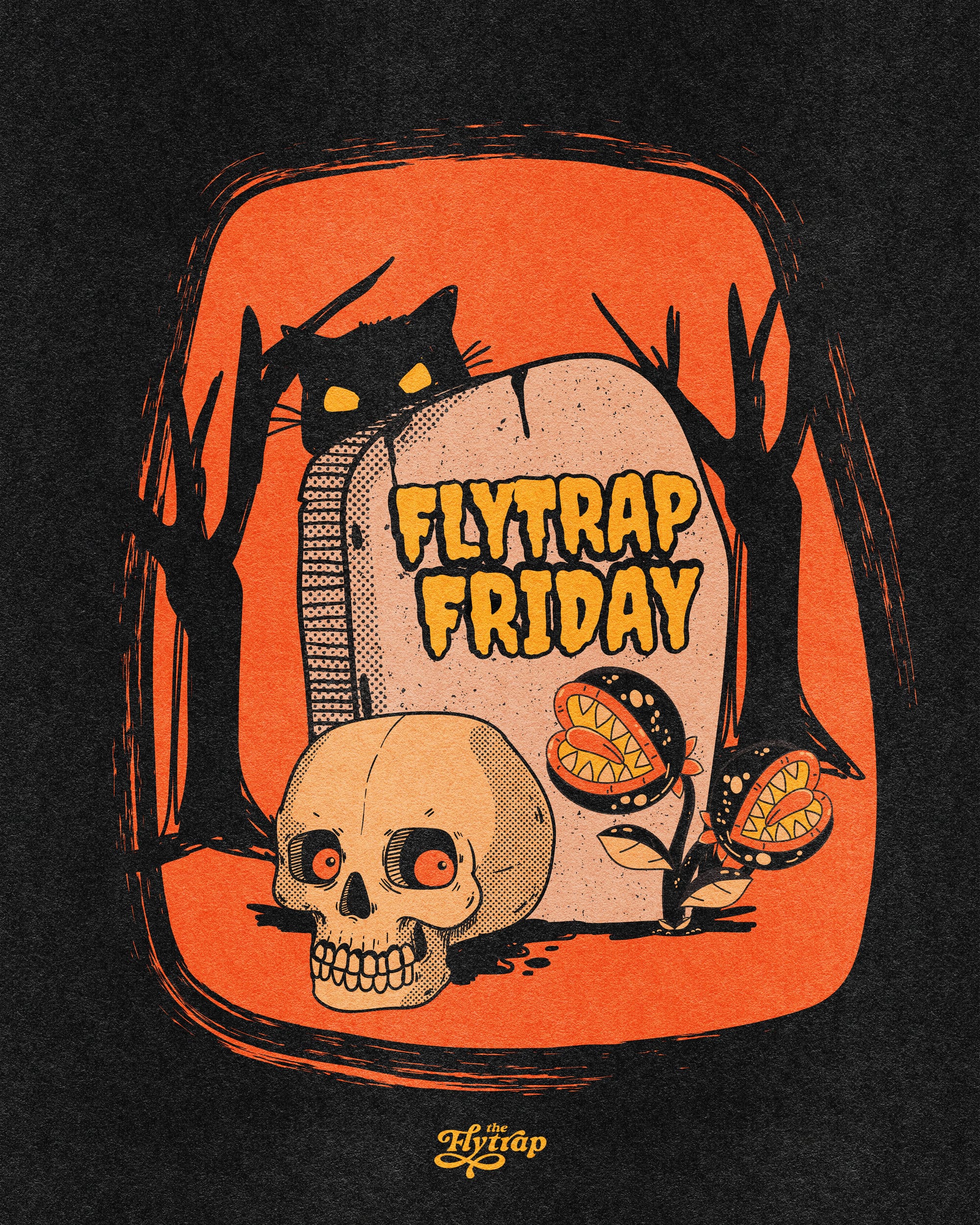
The madness starts in July, or “Summerween,” as my people call it.
There are some adjacent weirdos who use the summer months to cozyify their homes with fall decor, pretending it’s not sweltering outside and that their next pumpkin spice latte is just around the corner. But the real wackos get a jumpstart on Halloween. In my home, this mostly means one thing: designing my miniature Halloween village.
In case you’re wholly unfamiliar with this very Boomer-coded, quaint subculture, Doug Welker describes it as an offshoot of scale-modeling. (Maybe you’ve had an old man in your life obsessed with building elaborate model railroads? Well, Halloween villages are similar, only way cooler.)
Among “villagers,” as we’re called, Welker needs no introduction. The 41-year-old self-described “Halloween fanatic” is the creator of SpookyVillages.com, a website devoted to all things village. Welker is a bit of a Halloween influencer, with thousands of followers across his Facebook and YouTube pages, where he’s known for his intricate village scenes and honest product reviews. Because outside of having the time, patience, and creativity to construct small, spooky scenes, you’re going to need products. Lots and lots of products.
Before we continue further into this strange world of pinky-sized zombies, you should know that villagers generally fall into two camps when it comes to the products they prefer: Department 56 die-hards and Lemax lovers. Either way, “villaging” is the insular, quirky, and imperfect world we’re building together.
Feminist journalism is an endangered species, but The Flytrap is celebrating one year of biting back!
During our fall membership drive, we're hoping for 950 new and recurring subscribers. If you're ready and able to upgrade your membership to support worker-owned feminist media, our new Friends of the Flytrap subscribers get a 15% discount; that's $55.25 for a whole year of The Flytrap (plus other benefits)!
Setting the Scene
Department 56 has a sweet origin story of being created over 30 years ago by a florist in Minneapolis, Minnesota. Now headquartered in nearby Eden Prairie, the company is currently owned by the international corporation Enesco, LLC. However, Department 56’s wide array of original and licensed lighted buildings, figures, and accessories are still designed in-house by a very small stable of artists, most of whom have worked for the company for over two decades. For the purposes of this story, we’re focusing on Department 56’s Snow Village Halloween products, which first emerged in the late 1990s and now have a cult following—for good reason.
All of the company’s products are detailed, hand-crafted, and made out of ceramic or porcelain. Department 56’s Halloween products also happen to be incredibly clever. Who wouldn’t want Halloween’s newest hotspot, Monstertini's Nightclub, complete with a werewolf bouncer? Or a classic silver diner called Fly By Night that “glows like a spectral relic in the dead of night, beckoning hungry souls with its promise of devilishly good food”?
Now, if Department 56 is the Emmylou Harris of the villaging world, then Lemax is the Dolly Parton: all plastic, flashing lights, and fun.
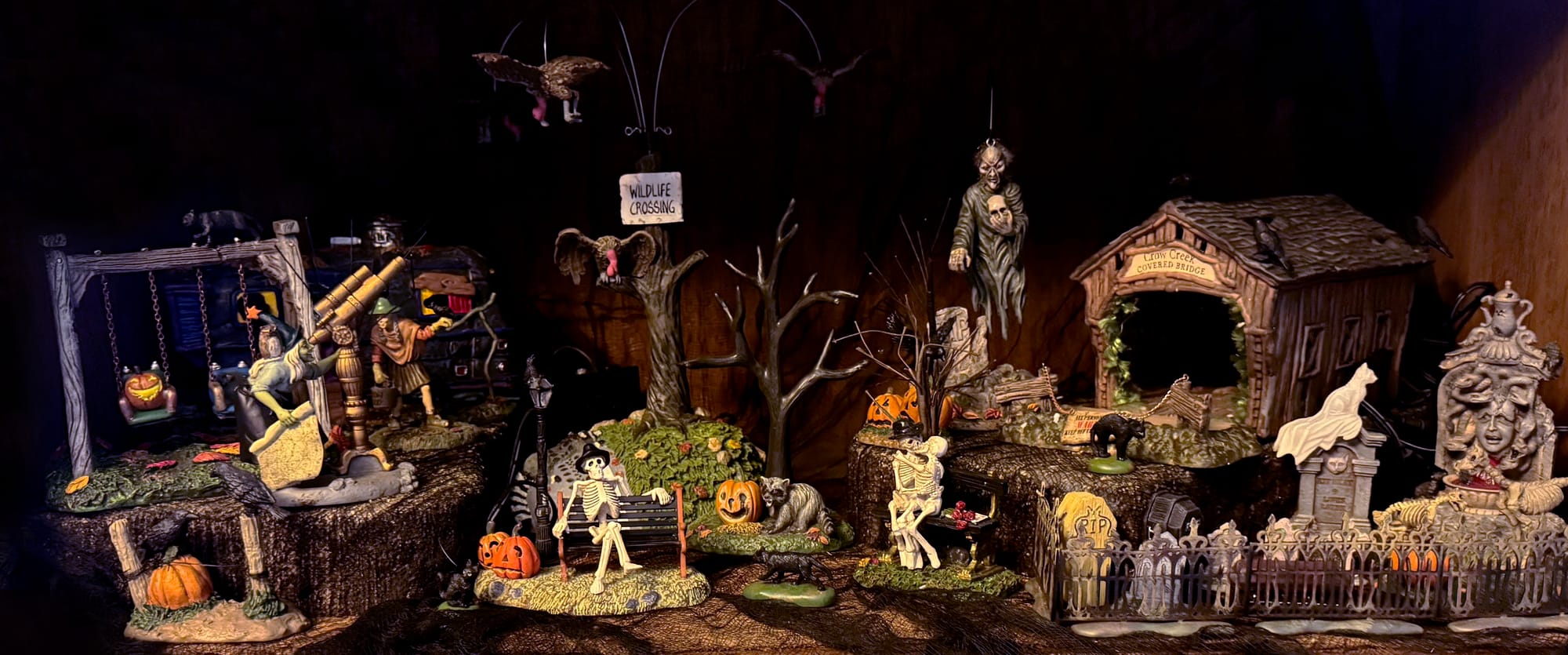
First formed in 1990, Lemax’s U.S. operations are based is based in Canton, Massachusetts, though Lemax’s marketing director, Emily Lee-Linehan, told The Flytrap that the company works with artists all over the country and currently has a team of 14. (We also reached out to Department 56 for an interview, but they did not respond to our request for comment.)
While Lemax’s products are mass-produced and not as detailed as Department 56’s, the company’s Halloween collection, Spooky Town, certainly wins in creativity due to its very large selection of village pieces that include sound, music, or motion. Lee-Linehan said the company didn’t expect the collection, first launched in 2000, “to be so well-received.”
“Well-received” is an understatement. Lemax and its fans should largely be credited with ushering in the Summerween trend. Each year, the company previews its new Halloween offerings in May. By the time the collection actually drops online and exclusively at Michaels in June, Lemax villagers are champing at the bit and sometimes wipe out the arts and crafts store’s new inventory within days. In fairness, it is spectacular inventory.
Whereas Department 56’s Halloween offerings lean a bit more respectable, Lemax’s Spooky Town is unhinged, fully embracing the darkness of the holiday. This year the company introduced a building piece called Dorian Grey’s Art Supplies, “a haunting mansion” where “cursed brushes line the shelves, waiting to bring your darkest visions to life.” Lemax products are also legitimately funny. Among its latest offerings are a dead wedding party with skeletons that actually shuffle across the dance floor, a graverobbing multigenerational family business called The Casket Monger, and “The Horror,” a skeleton figurine on a toilet who realizes he’s out of paper.
My all-time favorite Lemax village item is the Ghost Writer's Antique Bookstore. The haunted-looking storefront is located on Deadline Drive and features a skeleton typing alone in the window. (Very relatable content, says the woman at her window desk writing this story more than a week late.) Still, I am decidedly a Department 56 girlie, even though the average cost of one of the company’s lighted village buildings is around $200. Broadly, Halloween spending has hit a historic high, but I maintain my Department 56 loyalty not only because I’m numbers dumb and enjoy flushing money down the toilet. As cool and fun as Lemax products are—not to mention their kinder price point of about $60 for an animated building—I frankly don’t think their products are as well made. I’ve purchased more than a few Lemax items that didn’t even last a single season.
I also learned that for Department 56 villagers in particular, villaging is more than a hobby. It’s a way of life.
Welker is a Lemax guy, though like many villagers, he mixes and matches brands. Lemax actually namechecks Department 56 in its FAQs section and actively encourages people to utilize both companies. The company’s marketing director told The Flytrap that Lemax doesn’t view Department 56 as a competitor, given their very different strategies.
“We recognize that we don’t always have the full offering that collectors are shopping for, so we want our collectors to mix and match other brands so that they can create their dream village—even if it is not entirely all our company’s product,” Lee-Linehan explained. “Department 56 is a big corporation that offers many other seasons and other collectible items, but at Lemax we are a much smaller company… so we drive all our efforts and resources in one category: villages.”
Department 56, on the other hand, pretends Lemax doesn’t exist. According to Welker, this is one of the company’s many viability issues.
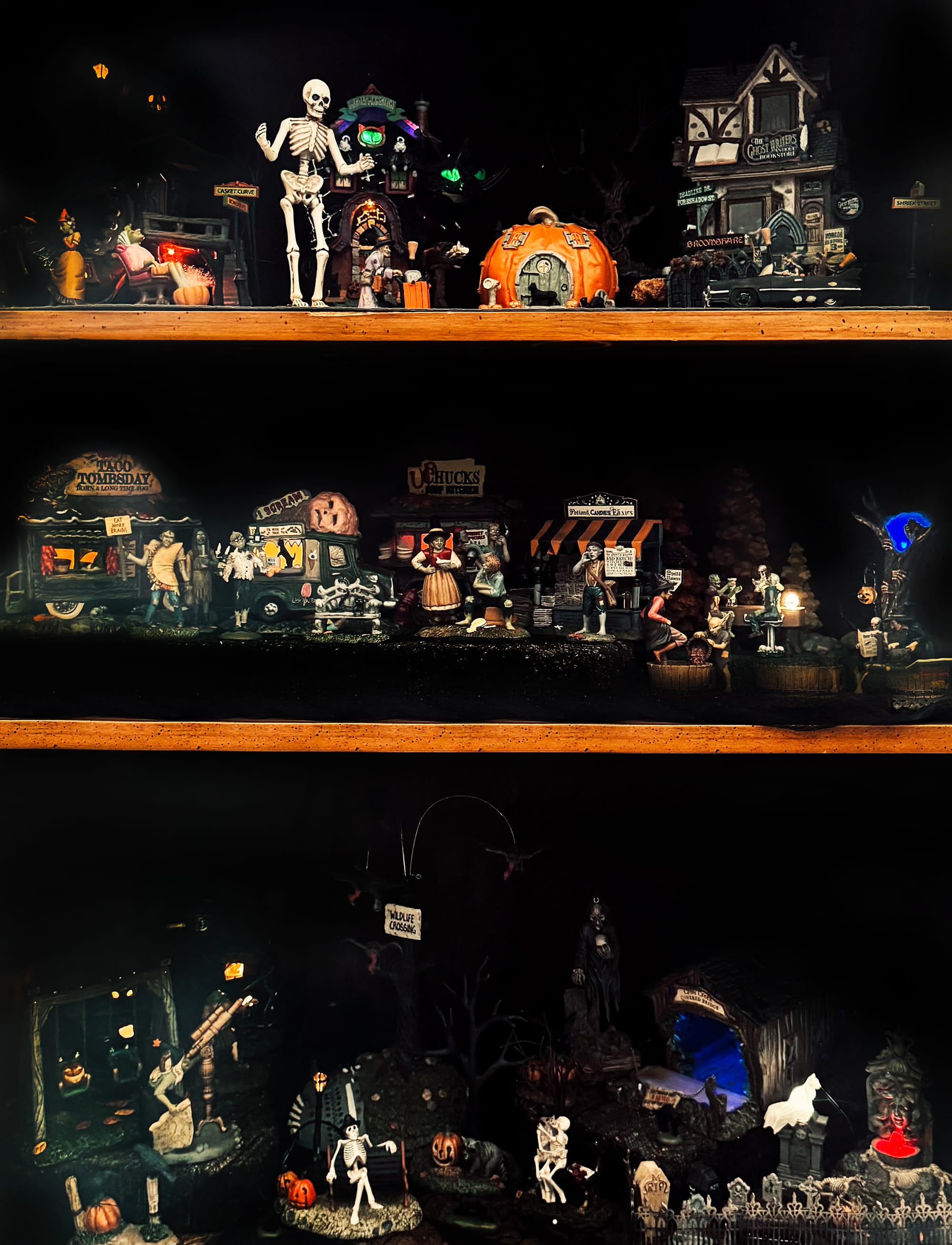
“Lemax is more accessible, and not just because of the price point,” Welker said. “Anyone can walk into a Michaels and find Lemax. You have to seek out Department 56 stuff, usually through a specialty dealer. Younger people definitely like Lemax more than Department 56, and if I were Department 56, I’d be pretty spooked about it. Their demographic is sort of disappearing.”
Admittedly, I’ve come across many a young person online trying to offload entire lots of Department 56 products they inherited from a grandparent or other elder in their life. While Welker and I are both in our 40s, we’re relatively young in the villaging world, especially among the Department 56 crowd. For more than a decade, the company has worked to appeal to younger consumers, in part with licensing deals representing an odd array of pop culture touchstones: Schitt’s Creek, Hello Kitty, Nightmare Before Christmas, Crayola, Harry Potter, and Mattel, among others. But the company seems to know where its bread is really buttered, which is why it ultimately targets an older crowd when choosing where to invest resources, such as its new gift shop and gallery inside Graceland.
Lee-Linehan explained that, according to Lemax’s analytics, the people browsing their Spooky Town products tend to be “a bit younger.” It seems that by simply producing a steady stream of outlandish, wonderful products each year, Lemax has successfully captured a wider—and relatively younger—range of Halloween fans, including (aging) goths and DIYers who use their village builds as fodder for YouTube channels.
Beyond age, I set out to learn more about my fellow villagers, first by scouring social media and then by actually reaching out to well-known figures such as Welker. I delicately asked demographic questions, though no one ever mentioned race or class, confirming my suspicion that I’ve landed on A Very White Hobby—one that requires disposable income. But I also learned that for Department 56 villagers in particular, villaging is more than a hobby. It’s a way of life.
Meeting ‘The Village People’
Despite claims otherwise, in my experience Latinos love spooky shit. Our belief in the spirit world is strong. We grow up with unsettling folklore. We commune with our dead and celebrate the supernatural in everyday life. Our spending power and magnetic attraction to the occult now drive corporate trends that market our own traditions and mythologies back to us.
Naturally, I thought I’d find other Latinos who enjoyed spending their free time and money preparing for Halloween by constructing elaborate, haunted worlds with the help of Department 56.
Boy, was I wrong.
But what I did find was a wonderful and wacky world of very devoted people who have taken their passion for villaging to astounding heights.
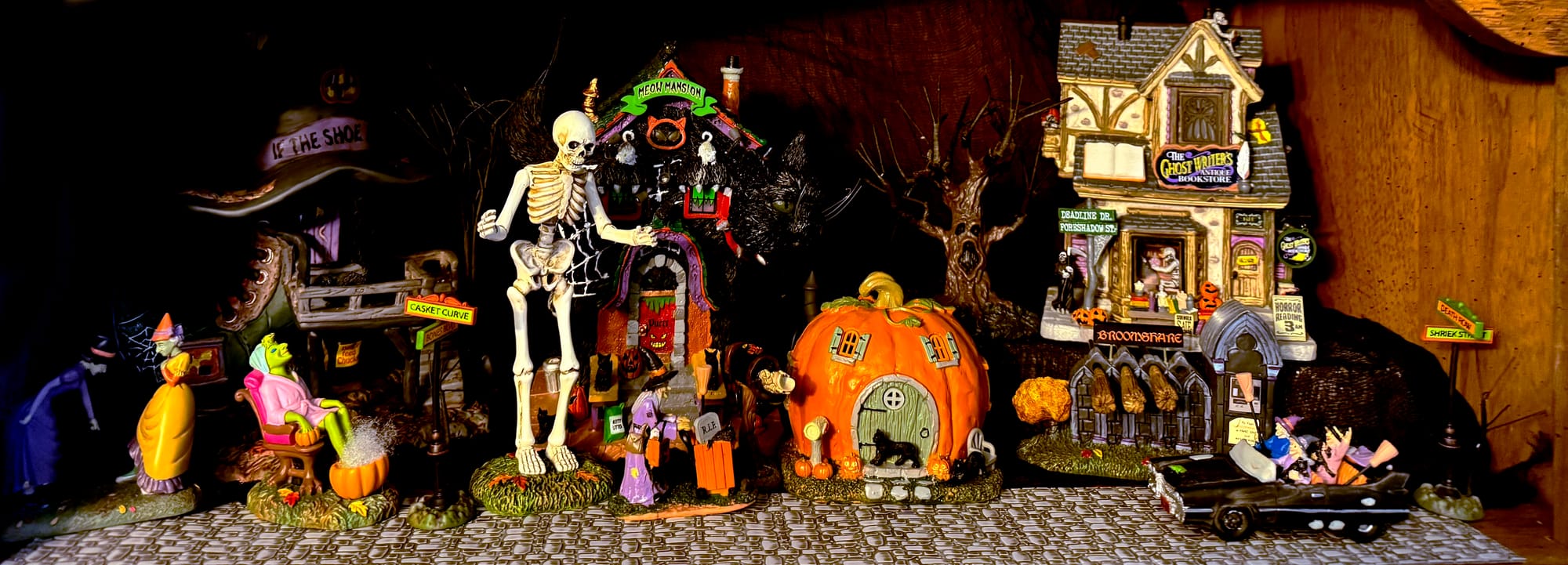
For example, before jumping into this story I was unaware of the National Council of 56 Clubs (NCC). First formed in 1992, the council is overseen by a national board of Department 56 enthusiasts, and the organization largely exists to connect Department 56 collectors to each other. As part of that mission, the NCC has dozens of clubs across the U.S. and Canada and is currently expanding to other countries.
Unlike the Lemax community, which Welker said is mostly active online, NCC clubs meet in person, and the organization also goes to great lengths to bring Department 56 villagers together. When I connected with NCC President Brandon Taylor, he had just returned from a cruise with 87 other Department 56 villagers.
Taylor is a Department 56 lifer. He got his first Department 56 house at the age of 8, attended his first villaging event at the age of 10, and at 44, he now has 700 Department 56 houses, most of which he keeps up a majority of the year.
“It really just started with one house, and there it went,” said Taylor, who’s based in Arkansas. “This has been part of my family since I was little. Every summer we’d go to Department 56 national conventions.”
For the few hours it took me to design my Halloween village, I didn’t once think of the authoritarian regime cruising city streets and racially profiling anyone vaguely brown and suspected of being an immigrant.
Taylor’s wife and children are now villagers, and it saddens him that people of our generation are responsible for “the destruction” of the hobby. His theory is that minimalist aesthetics and our cultural obsession with tech have pulled people away from the quaint world of villaging. While he admits Department 56 has historically struggled to entice people under 40, the company’s more recent licensed Halloween offerings, namely Beetlejuice and Hocus Pocus, have made some headway—and Taylor would know. He’s worked at a store for 22 years that sells the company’s products and, as NCC president, he has a direct line to Department 56.
“Simply put, they are the gold standard,” Taylor said. “If you see a piece in a magazine or online, it pales in comparison to when you see it in person. It’s all so detailed and beautiful. I think of the pieces as miniature works of art.”
While Lemax villagers like Welker see Department 56 products as inaccessible, Taylor argues that the company makes its artists very accessible to fans. Artists often appear at NCC gatherings and attend store events, where they sign their Department 56 designs like rockstars.
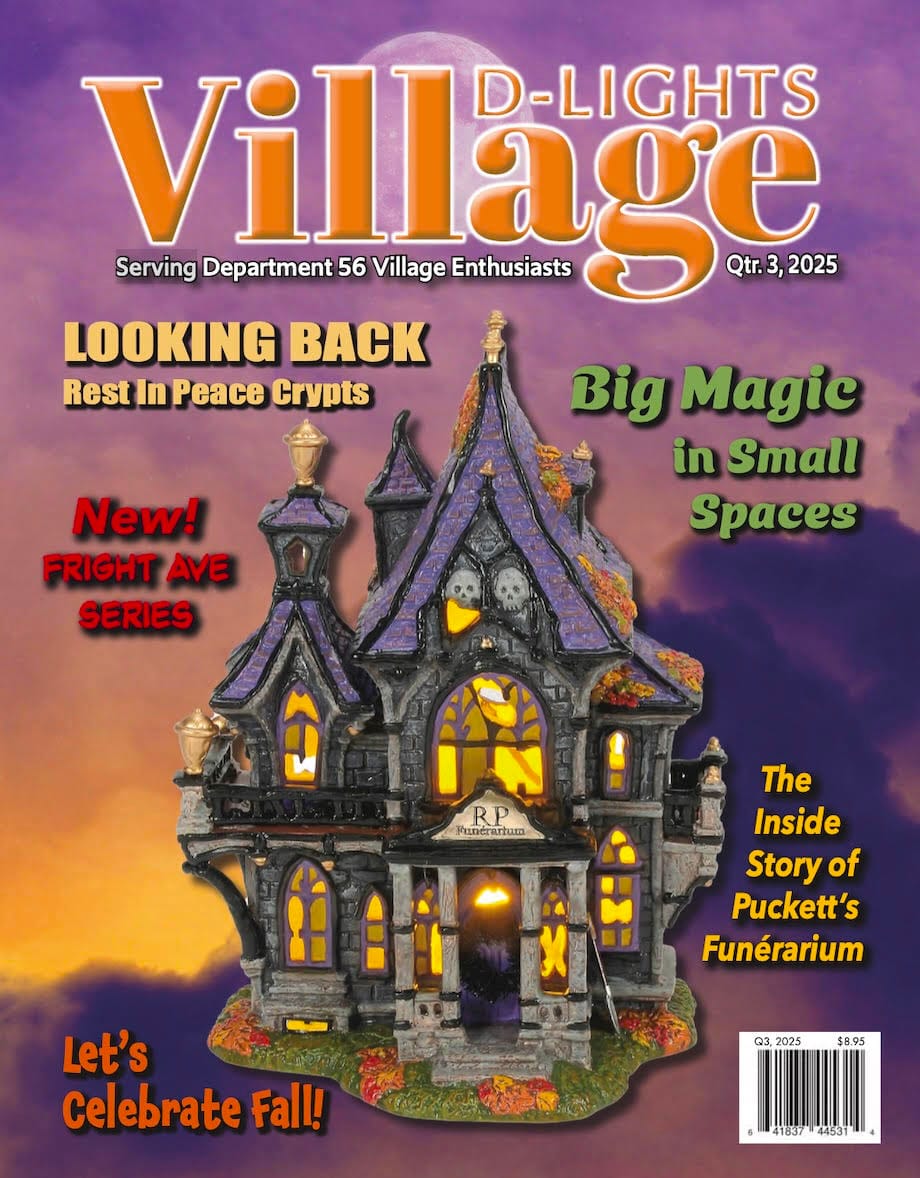
And writing about these rockstars is Benjamin Osten, whose Village D-Lights Magazine serves as the media arm of the Department 56 fandom. As a collector, Osten’s focus is less about displaying his entire collection and more about taking an artistic approach to “creating a visual scene on a miniature level.” Osten is relatively new to collecting. For him, it started about seven years ago when he was looking for something small and decorative to put under his Christmas tree. He stumbled across Department 56 and instantly fell in love, purchasing 40 houses in one go. By the end of the Christmas season, he had 60. The following year, he bought an entire U-Haul’s worth of Department 56 products. Needless to say, the obsession had taken hold.
About three years into being a collector, Osten discovered Department 56’s vast community network. He’s now a member of the NCC and a local villaging club.
“My friends are super supportive, but I’m sure they think I’m nuts,” Osten said. “Buying all of the houses is one thing, but then I bought the magazine too. Inevitably you look for a community of folks who understand the obsession.”
Debby Cherenzia once had her Halloween village featured in Village D-Lights. She got bit by the Department 56 bug more than 30 years ago. For her, villaging triggered nostalgic childhood memories of her mom setting up a train under the family Christmas tree. Like Osten, the first time she saw a Department 56 village, she bought the entire collection. Cherenzia said it wasn’t long before she was at her first convention and a member of the NCC, where she’s currently treasurer.
“It’s nice to get involved and go to a convention and realize: There’s other crazy people like me,” Cherenzia laughed. “You meet so many good people. I call us ‘the village people,’ and so many have become my good, close friends. We travel to conventions and events together. This is a lot of my social life now.”
The in-person community cultivated by Department 56 collectors is an important part of the villaging experience, said Taylor, who likens these events to a family gathering.
“These are people you call and text because you sort of crave to be around others who are just as crazy about collecting as you are,” Taylor said. “The in-person events really showcase what collecting is about; it’s the human side of it. It’s about that connection; that friendship; that lifelong bond over tiny real estate.”
Did you love The Flytrap's art from amazing freelance artists and Art Director rommy torrico in general? You can grab the art from this year's Flytrap Fridays along with other cool things, such as rommy's fantastic "Shorten the Cycle" poster that accompanied Katelyn Burns' inaugural post about how the election cycle is too damn long, at our merch store!
I guess I’m an outlier in the villaging world in more ways than one. I don’t crave the personal connection that Taylor and others speak of so fondly.
I purchased my first Department 56 piece in 2020 at the height of the pandemic, when people across the U.S. picked up hobby crafts as “reactive pastimes.” Then and now, my villaging is a happily solitary hobby that’s more about escapism than anything else. During the first year of Covid, when my elderly dad was a janitor at a hospital, I focused on building a small world that only I could control.
This year, for the few hours it took me to design my Halloween village, I didn’t once think of the authoritarian regime cruising city streets and racially profiling anyone vaguely brown and suspected of being an immigrant. I didn’t fret about the evils of AI or sulk about the previous weeks I spent sifting through dozens of AI-generated pitches, written by soulless AI reporters.
It was just me and my village, alone at last.
This piece was edited by Chrissy Stroop and copyedited by Andrea Grimes.

